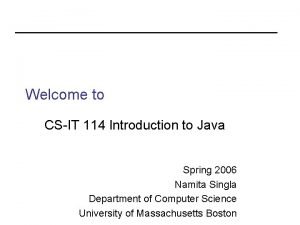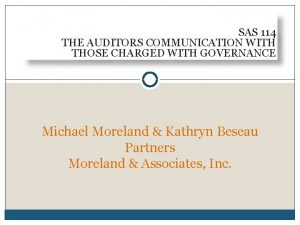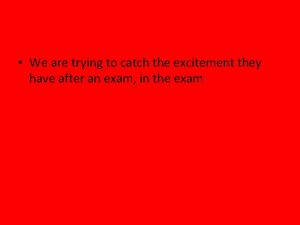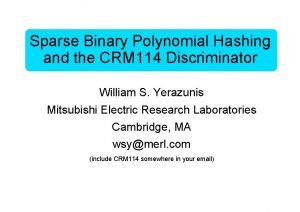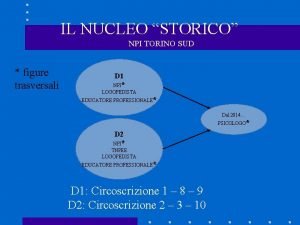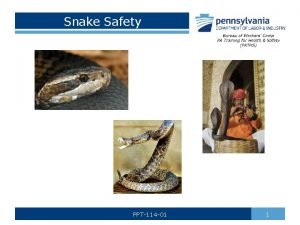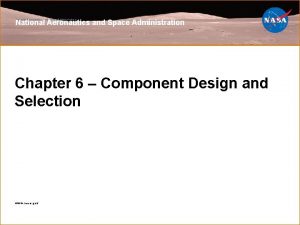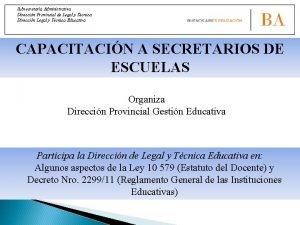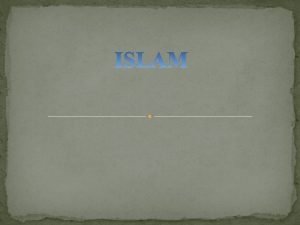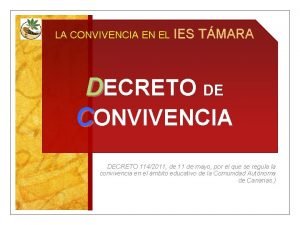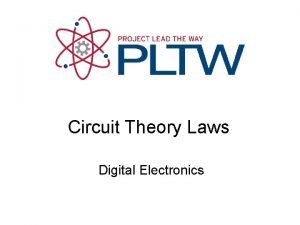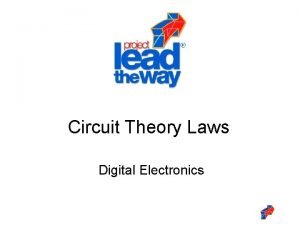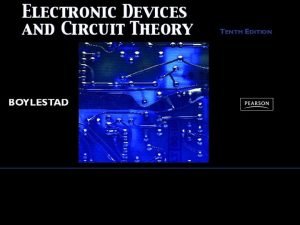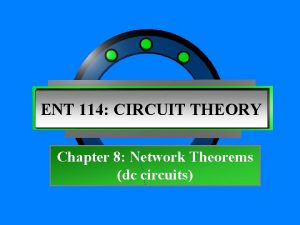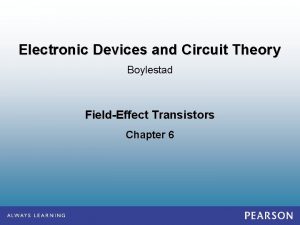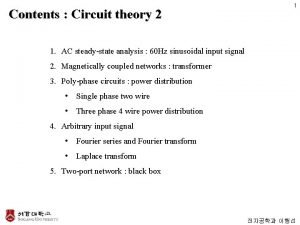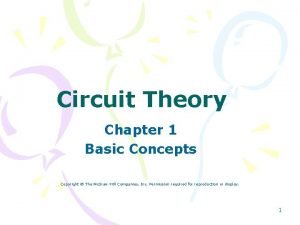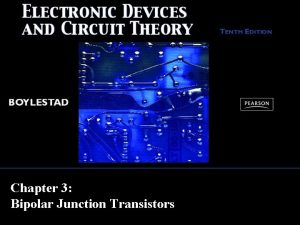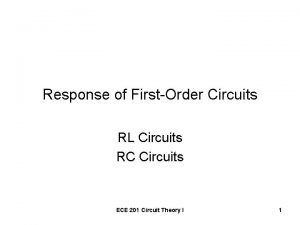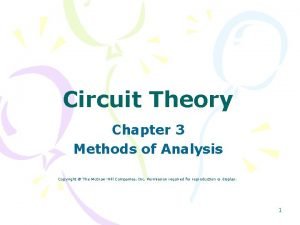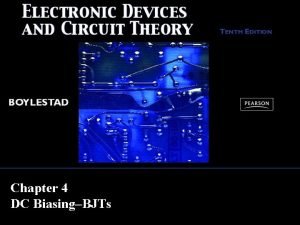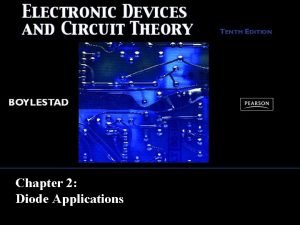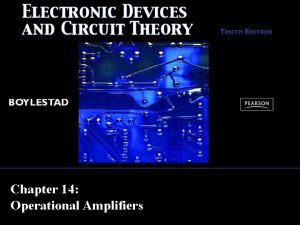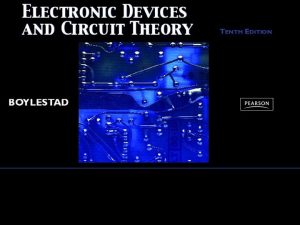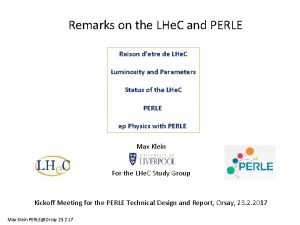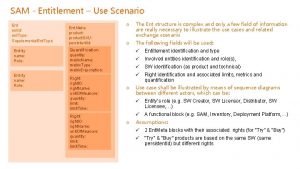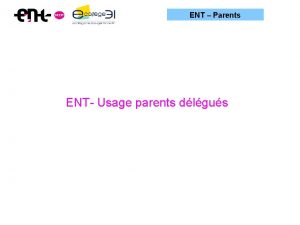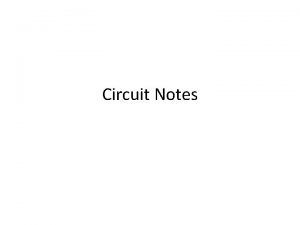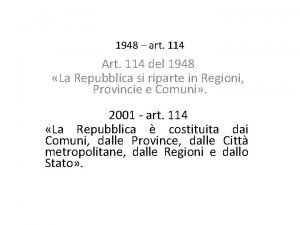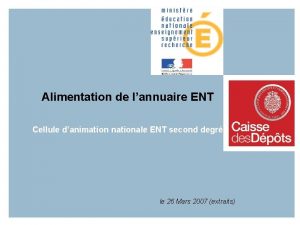Chapter 1 ENT 114 CIRCUIT THEORY Chapter 2












































- Slides: 44

Chapter 1 ENT 114: CIRCUIT THEORY Chapter 2 Principles of Electric Circuits - Floyd © Copyright 2006 Prentice-Hall

Chapter 2 Voltage, Current and Resistance Principles of Electric Circuits - Floyd © Copyright 2006 Prentice-Hall

Chapter 2 Force There is a force (F) between charges. Like charges repel; unlike charges attract. • The force is directly proportional to charge. • The force is inversely proportional to square of distance. Principles of Electric Circuits - Floyd © Copyright 2006 Prentice-Hall

Chapter 2 • The force of attraction or repulsion between two charged bodies Q 1 and Q 2 can be determined by Coulomb’s Law: • Where F is in Newtons (N), k a constant = • Q 1 and Q 2 are the charges in coulombs Principles of Electric Circuits - Floyd © Copyright 2006 Prentice-Hall

Chapter 2 Voltage Every source of voltage is established by simply creating a separation of +ve and –ve charges Work is done as a charge is moved in the electric field from one potential to another. Voltage is the work per charge done against the electric field. Principles of Electric Circuits - Floyd © Copyright 2006 Prentice-Hall

Chapter 2 Voltage Definition of voltage One volt is the potential difference (voltage) between two points when one joule of energy is used to move one coulomb of charge from one point to the other. One Coulomb of charge is the total charge associated with 6. 242 x 108 electrons Principles of Electric Circuits - Floyd © Copyright 2006 Prentice-Hall

Chapter 2 Voltage is responsible for establishing current. Sources of voltage include batteries, solar cells, and generators. A Cu-Zn battery, such as you might construct in a chemistry class, is shown. Principles of Electric Circuits - Floyd © Copyright 2006 Prentice-Hall

Chapter 2 Current (I) is the amount of charge (Q) that flows past a point in a unit of time (t). One ampere is a number of electrons having a total charge of 1 C move through a given cross section in 1 s. What is the current if 2 C passes a point in 5 s? 0. 4 A Principles of Electric Circuits - Floyd © Copyright 2006 Prentice-Hall

Motion of 2 negatively charged electrons in a copper wire when Chapter placed across battery terminals with a difference in potential of volts (V). Principles of Electric Circuits - Floyd © Copyright 2006 Prentice-Hall

Chapter 2 Current (I) is the amount of charge (Q) that flows past a point in a unit of time (t). • Flow of electric charges – -ve charge (electron) flow to +ve terminal. – + ve charge flow to –ve terminal – This motion creates electric current • It is conventional to take the current flow as the movement of positive charge, that is opposite to the flow of electron. Principles of Electric Circuits - Floyd © Copyright 2006 Prentice-Hall

Chapter 2 Current • Electric current is the time rate of change of charge, measured in amperes (A) • 1 A=1 C/s • Direct current (dc): current that remains constant with time. • Alternating current (ac): current that varies sinusodally with time. i = current in ampere q= charge in coulomb t = time in second Principles of Electric Circuits - Floyd © Copyright 2006 Prentice-Hall

Chapter 2 Current direct current exponential current Principles of Electric Circuits - Floyd Alternating current Damped current © Copyright 2006 Prentice-Hall

Chapter 2 Voltage Sources Generally can be divided into: a) Batteries (chemical reaction) b) Generators (electro-mechanical) c) Power supplies (rectification) Principles of Electric Circuits - Floyd © Copyright 2006 Prentice-Hall

Chapter 2 Voltage Sources Principles of Electric Circuits - Floyd © Copyright 2006 Prentice-Hall

Chapter 2 Voltage Sources Principles of Electric Circuits - Floyd © Copyright 2006 Prentice-Hall

Chapter 2 Resistance • The flow of charge through any material encounters an apposing force similar in many respect to mechanical friction. • This opposition, due to the collision between electrons and between electron and other atoms in material, which converts electrical energy into heat, is called the resistance of material. • The unit of measurement of resistance is the ohm, for which the symbol is Ω. Principles of Electric Circuits - Floyd © Copyright 2006 Prentice-Hall

Chapter 2 Resistance • The circuit symbol for resistance : • The resistance of any material with a uniform cross-sectional area is determined by the following factors: – Material – Length – Cross-sectional Area – Temperature Principles of Electric Circuits - Floyd © Copyright 2006 Prentice-Hall

Chapter 2 Resistance • At a fixed temperature of 20°C, the resistance is related to the other 3 factor by, • Where; – ρ (Greek letter rho) is the characteristic of the material called resistivity, – l is the length of the sample – A is the cross-sectional area of the sample Principles of Electric Circuits - Floyd © Copyright 2006 Prentice-Hall

Chapter 2 Resistance • The higher the resistivity, the greater the resistance of conductor • The longer the conductor, the greater the resistance • The greater the area of a conductor, the less the resistance Principles of Electric Circuits - Floyd © Copyright 2006 Prentice-Hall

Chapter 2 Resistance: Temperature Effect • Temperature have a significant effect on the resistance of conductors, semiconductors and insulators. • Conductors – For good conductors, an increase in temperature will result in an increase in the resistance level. Consequently conductors have a positive temperature coefficient. • Semiconductor – For semiconductor materials, an increase in temperature will result in a decrease in the resistance level. Consequently, semiconductors have negative temperature coefficient. • Insulators = Semiconductors Principles of Electric Circuits - Floyd © Copyright 2006 Prentice-Hall

Chapter 2 Resistance: Temperature Effect • For a moderate range of temperature, such as 100°C, the change of resistance is usually proportional to the change of temperature; • The ratio of the change of resistance per degree change of temperature to the resistance of some definite temperature are called coefficient of resistance, α. Principles of Electric Circuits - Floyd © Copyright 2006 Prentice-Hall

Chapter 2 Resistance is the opposition to current. One ohm (1 W) is the resistance if one ampere (1 A) is in a material when one volt (1 V) is applied. Conductance is the reciprocal of resistance. Components designed to have a specific amount of resistance are called resistors. Principles of Electric Circuits - Floyd © Copyright 2006 Prentice-Hall

Chapter 2 Resistance Principles of Electric Circuits - Floyd © Copyright 2006 Prentice-Hall

Chapter 2 Resistance Principles of Electric Circuits - Floyd © Copyright 2006 Prentice-Hall

Chapter 2 Resistance Principles of Electric Circuits - Floyd © Copyright 2006 Prentice-Hall

Chapter 2 Hanya Pada Mu Jiwa Ku Hancur Berkecai Untuk Kekasih Pertama Haji Pak Mat Jiran Kita Hidup Berkebun Ubi Kayu Putih Haji Pak Mat Orang Kaya Hendak Beli Ubi Kayu Putih Big Boy Rape One Young Girl But Very Gently Why Principles of Electric Circuits - Floyd © Copyright 2006 Prentice-Hall

Chapter 2 Resistance What is the resistance and tolerance of each of the four-band resistors? 5. 1 k. W ± 5% 8. 2 W ± 10% 49 W ± 10% 1. 0 W ± 5% Principles of Electric Circuits - Floyd © Copyright 2006 Prentice-Hall

Chapter 2 Resistance Alphanumeric Labeling • Two or three digits, and one of the letters R, K, or M are used to identify a resistance value. • The letter is used to indicate the multiplier, and its position is used to indicate decimal point position. Principles of Electric Circuits - Floyd © Copyright 2006 Prentice-Hall

Chapter 2 Resistance Variable resistors include the potentiometer and rheostat. A potentiometer can be connected as a rheostat. The center terminal is connected to the wiper Principles of Electric Circuits - Floyd © Copyright 2006 Prentice-Hall

Chapter 2 Basic Circuit A basic circuit consists of 1) a voltage source, 2) a transmission system and 3) a load 4) a control apparatus. An example of a basic circuit is the flashlight, which has each of these. Principles of Electric Circuits - Floyd © Copyright 2006 Prentice-Hall

Chapter 2 Basic Circuit Elements • One element on simple circuit is a mathematical model for electric apparatus that have two terminals. Basic Circuit Elements Active Elements v. Could supplied power to circuits v. Example : Voltage and Current source Principles of Electric Circuits - Floyd Passive Elements v. Only could absorb power v. Example : resistor, inductor, capasitor etc. © Copyright 2006 Prentice-Hall

Chapter 2 Voltage and Current Source • An ideal Independent source is an active element that provides a specified voltage or current that is completely independent of other circuit element • An Ideal Dependent source is an active element which the source quantity is controlled by another voltage or current. Principles of Electric Circuits - Floyd © Copyright 2006 Prentice-Hall

Chapter 2 Independent source Voltage Principles of Electric Circuits - Floyd Current © Copyright 2006 Prentice-Hall

Chapter 2 Dependent source dependent voltage. Controlled voltage source dependent voltagecontrolled current source Principles of Electric Circuits - Floyd dependent currentcontrolled voltage source dependent currentcontrolled current source © Copyright 2006 Prentice-Hall

Chapter 2 DMM An important multipurpose instrument is the DMM, which can measure voltage, current, and resistance. Many include other measurement options. Principles of Electric Circuits - Floyd © Copyright 2006 Prentice-Hall

Chapter 2 Selected Key Terms Ampere The unit of electrical current AWG (American Wire Gauge) A standardization based on wire diameter Charge An electrical property of matter that exists because of an excess or a deficiency of electrons. Charge can be either + or -. Circuit An interconnection of electronic components designed to produce a desired result. A basic circuit consists of a source, a load, and an interconnecting path. Principles of Electric Circuits - Floyd © Copyright 2006 Prentice-Hall

Chapter 2 Selected Key Terms Conductance The ability of a circuit to allow current. The unit is the siemans (S). Coulomb The unit of electrical charge. Current The rate of flow of electrical charge. Electron A basic particle of electrical charge in matter. The electron possesses a negative charge. Ground The common or reference point in a circuit. Ohm (W) The unit of resistance. Principles of Electric Circuits - Floyd © Copyright 2006 Prentice-Hall

Chapter 2 Selected Key Terms Potentiometer A three-terminal variable resistor. Resistance The opposition to current. the unit is the ohm (W). Rheostat A two-terminal variable resistor. Siemens The unit of conductance Volt The unit of voltage or electromotive force. Voltage The amount of energy per charge available to move electrons from one point to another in an electric circuit. Principles of Electric Circuits - Floyd © Copyright 2006 Prentice-Hall

Chapter 2 Quiz 4. The symbol for charge is a. C b. W c. Q d. W Principles of Electric Circuits - Floyd © Copyright 2006 Prentice-Hall

Chapter 2 Quiz 5. The definition for voltage is a. b. c. d. Principles of Electric Circuits - Floyd © Copyright 2006 Prentice-Hall

Chapter 2 Quiz 6. A battery stores a. electrons b. protons c. ions d. chemical energy Principles of Electric Circuits - Floyd © Copyright 2006 Prentice-Hall

Chapter 2 Quiz 7. The unit of conductance is the a. ohm b. coulomb c. siemen d. ampere Principles of Electric Circuits - Floyd © Copyright 2006 Prentice-Hall

Chapter 2 Quiz 8. A four-color resistor with the color bands gray-redblack-gold is a. 73 W b. 82 W c. 680 W d. 820 W Principles of Electric Circuits - Floyd © Copyright 2006 Prentice-Hall

Chapter 2 Quiz 9. A 330 k. W ± 5% resistor has the color bands a. red-brown-gold b. orange-yellow-gold c. yellow-red-gold d. yellow-green-gold Principles of Electric Circuits - Floyd © Copyright 2006 Prentice-Hall
 Pseudocolor image processing
Pseudocolor image processing Csit 114
Csit 114 Sas 114
Sas 114 Phys 250 ubc
Phys 250 ubc Taskj-114
Taskj-114 Who wrote psalm 114
Who wrote psalm 114 Stężenie procentowe
Stężenie procentowe Crm 114 discriminator
Crm 114 discriminator Figure equicomposte
Figure equicomposte Fact act
Fact act Ppt114
Ppt114 Aiaa s-114
Aiaa s-114 Oesd 114
Oesd 114 Tercera estación del vía lucis
Tercera estación del vía lucis Hbu 112
Hbu 112 Solicitud de licencia articulo 114 y 115 decreto 688/93
Solicitud de licencia articulo 114 y 115 decreto 688/93 Powstanie islamu
Powstanie islamu Decreto 114/2011
Decreto 114/2011 Parallel vs series
Parallel vs series Parallel circuit with 3 bulbs
Parallel circuit with 3 bulbs Circuit construction kit
Circuit construction kit In series vs in parallel
In series vs in parallel Complete and incomplete circuits
Complete and incomplete circuits Short circuit diagram
Short circuit diagram Formula for venn diagram with 3 circles
Formula for venn diagram with 3 circles The circulatory system
The circulatory system Advantages of parallel circuits over series circuits
Advantages of parallel circuits over series circuits Rl circuit theory
Rl circuit theory Vir
Vir Circuit theory
Circuit theory Fet frequency response
Fet frequency response Voltage devider rule
Voltage devider rule Electronic devices and circuit theory
Electronic devices and circuit theory Circuit theory 2
Circuit theory 2 Circuit theory basic concepts
Circuit theory basic concepts Electronic devices and circuit theory
Electronic devices and circuit theory Solving first order circuits
Solving first order circuits Circuit theory 3
Circuit theory 3 Electronic devices and circuit theory
Electronic devices and circuit theory Boylestad
Boylestad Boylestad
Boylestad Feedback and oscillator circuits
Feedback and oscillator circuits Dr max klein ent
Dr max klein ent Template
Template Ent guynemer toulouse
Ent guynemer toulouse

